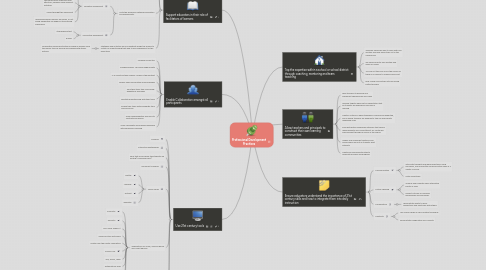
1. Tap the expertise within a school or school district through coaching, mentoring and team teaching
1.1. Teachers should be able to work with one another and help each other out in the classrrooms
1.2. We should mentor one another and share our ideas
1.3. You are not the only one in the school so there is no reason to single yourself out
1.4. help coach one another into becoming better teachers
2. Allow teachers and principals to construct their own learning communities
2.1. have the skills to develop and implement shared goals and vision
2.2. develop targets which set an expectation that all students will experience success in learning
2.3. create a culture in which teamwork is valued and expected, and in which teachers are enabled to take on appropriate leadership roles
2.4. build distributed leadership networks that secure responseabilty and committment for continued improvement through all levels of the school
2.5. modify and challenge traditions and values which are not in students’ best interests
2.6. create and lead opportunities to celebrate success and progress
3. Ensure educators understand the importance of 21st century skills and how to integrate them into daily instruction
3.1. Communication
3.1.1. Articulate thoughts and ideas effectively using nonverbal, oral and written communication skills in a variety of forms
3.1.2. Listen Effectively
3.2. Critical Thinking
3.2.1. Analyze and evaluate major alternative points of view
3.2.2. Reflect critically on learning experiences and processes
3.3. Collaboration
3.3.1. demonstrate ability to work respectfully and efectively with others
3.4. Creativity
3.4.1. Use a wide range of idea creation technique
3.4.2. Demonstrate imagination and curiosity
4. Support educators in their role of facilitators of learners
4.1. formulate a learning plan
4.2. Objectives are clear and functional
4.2.1. developed and stated on bases of what you want the learner to do.
4.3. Note the difference between evaluation and assessments
4.3.1. formative assessment
4.3.1.1. includes feedback to both teacher and learners of next steps that needto be taken
4.3.1.2. Identifying areas requiring more attention, perhaps using different activities
4.3.1.3. Asses throught the assesment
4.3.1.4. recognizing when learners are bored, or not being adequately en-gaged in the learning experience
4.3.2. Summative assessment
4.3.2.1. standardized test
4.3.2.2. quizes
4.4. strategies and activities are includedthat brings the learner to a state of understanding that lead to accomplishment of the objectives
4.4.1. cooperative learning activities included in lessons allow the learner tomove around and engage with others actively
5. Enable Collaboration amongst all participants
5.1. Increase Porductivy
5.2. Engage workers and encourage growth
5.3. In a collective team believe power is the greatest
5.4. Openly share information and knowledge
5.5. from their team they encourage sggestions and ideas
5.6. facilitate brainstorming with their team
5.7. Enable their team with immediate time and recources
5.8. Allow responsabilites and roles to fluctuate and evolve
5.9. Offer immediate and ongoing feedback with persalized coaching
6. Use 21st century tools
6.1. Dropbox
6.2. Interactive whiteboards
6.3. Pens that record while the students are writing (Livescribe pens)
6.4. Document Cameras
6.5. Social Media
6.5.1. Twitter
6.5.2. YouTube
6.5.3. Pintrest
6.5.4. Websites
6.6. Applications for IPads, Chrome Books and Smart phones
6.6.1. Evernote
6.6.2. Animoto
6.6.3. HMH Fuse Algebra 1
6.6.4. Oxford Picture Dictionary
6.6.5. Poetry from the Poetry Foundation
6.6.6. School Fuel
6.6.7. See, Touch, Learn
6.6.8. Slatemath for Kids
6.6.9. Springpad
6.6.10. Wonders of the Universe
